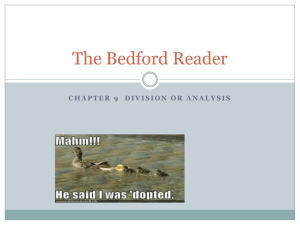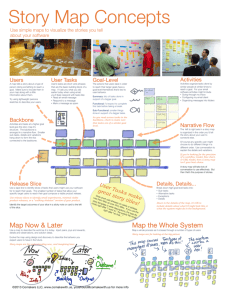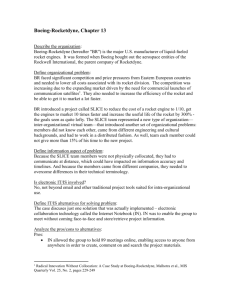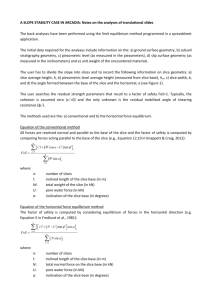Monte Carlo Simulation Palisade User Conference 2007 Real Options Analysis www.riskreturnsolutions.com
advertisement
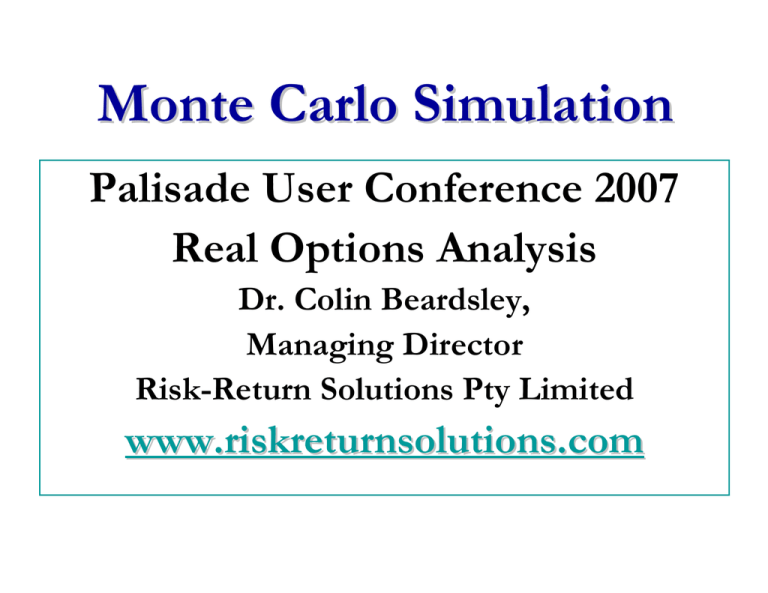
Monte Carlo Simulation Palisade User Conference 2007 Real Options Analysis Dr. Colin Beardsley, Managing Director Risk-Return Solutions Pty Limited www.riskreturnsolutions.com The Plot Today • We will review firstly basic option concepts and terminology both for financial options and for real options • We will then introduce the concept of Risk Neutrality • We will discuss how the Black-Scholes Option Pricing Model (BSOPM) can be used to value real options • We will use a version of the BSOPM to value embedded options in long term property leases and how to exploit volatility in the property market A word of caution! • Options are difficult and real options are real difficult • Because of time constraints, I have oversimplified some of the concepts and, certainly, some of the mathematics behind option pricing theory • @ RISK Monte Carlo simulation is an ideal approach for valuing both real and financial options – most of the books and literature focus on binomial modelling – Excel example of multi-period model – but this approach is not flexible enough • I will be happy to go further into the subject with any of you who are interested during the conference Volatility • Volatility is the speed at which the value of the underlying asset tends to diverge randomly away from and around today’s value • Higher volatility means a larger expected speed of divergence • Very important! The more volatile the underlying the more valuable is the option • Real options analysis assumed each value driving factor is subject to an unforcastable random walk or, in a special case of Monte Carlo simulation a user defined probability distribution Valuing Real Options: Comparison of variables for financial and real options n.b. Real Options are much, much longer than financial options Stock price – changes continually NPV of potential investment – changes continually Underlying asset of stock Potential physical or intellectual investment Fixed price at which we can buy (call) or sell (put) a unit of stock Fixed price at which we can make a business investment or sell it up Time to expiration Time until opportunity disappears Stock value uncertainty Project uncertainty Riskless interest rate Riskless interest rate (as adjusted by Market Price of Risk) Why Real Options . . . . ? The actual market place is characterised by change, uncertainty and competitive interactions. So the realisation of cash flows is far more random and as future cash flows resolve management may have valuable flexibility to alter its operating strategy in order to capitalise on favourable future opportunities or to mitigate losses. Management’s flexibility to adapt its future actions in response to altered future market conditions expands an investment opportunity’s value by improving its upside potential while limiting downside losses relative to management’s initial expectations under passive management. The resultant asymmetry caused by management flexibility calls for an expanded NPV rule reflecting: Passive NPV of expected cash flows + value of options from active management Case Study - Property Derivatives: A very simple first look at Risk Neutrality • Property value = $100,000,000 • Required return = 9% p.a. • Risk Premium = 3% p.a. • Risk Free Rate = 6% p.a. Using this simple example, first we need to discuss what happens when we value in a risk averse world and in a risk neutral world Our Risk Averse World Discounted Property Value in one year’s time is the return on the property discounted by the Risk Free Rate (6% p.a.) plus a Risk Premium called The Market Price of Risk (3% p.a.): p.a.) $100,000,000 * (1 + 9.0%[Return]) = $100,000,000 (1 + 6.0%[RFR] + 3.0%[Risk Premium]) A Risk Neutral World This approach ‘neutralizes’ investors’ risk preferences at source – the risk premium is subtracted from the required return. The payoff is then discounted by the Risk Free Rate. Risk Neutrality is critical for valuing random payoffs. All payoffs – high or low – represent investment opportunity not risk. risk $100,000,000 * (1 + 9.0% − 3.0%) = $100,000,000 (1 + 6.0%) But – Real Options Are Different Animals!!! • Valuing projects (including property) using derivative techniques is different from conventional DCF valuation techniques. techniques • The classic Black-Scholes model assumes the value of the property (the underlying) follows two combined processes which result in a series of stochastic (random) outcomes: 1. 2. A periodic ‘drift’ reflecting expected return, return plus A random element reflecting jolts in the market (volatility) Behaviour of Property Prices (1): Drift Model of behaviour of property prices (1) 16 Propertyvalue 14 12 10 8 6 4 2 0 Time Drift Behaviour of Property Prices (2): Random Jolts Model of behaviour of property prices (2) 12 Propertyvalue 10 8 6 4 2 0 -2 -4 Time Drift Random Generalised Property Process (3): Geometric Brownian Motion Model of behaviour of property prices (3) Propertyvalue 15 10 5 0 -5 Time Random Element Projected path Drift Valuing Real Options in Property: Path dependency makes options natural candidates for simulation where we can examine easily the risk/return characteristics of the project. We can project the future value of the underlying asset and then designate an output cell or cells to be the discounted value of the put or call options embedded in the project. The mean of the output cell is the fair value of the real option. We will focus on the property market which is a natural candidate for real options – there is a growing market for Property Derivatives Deriving Rentals Rentals are assumed to be derived from property values much in the same way as a dividend is derived from a share The whole package of residual property value plus rentals is then discounted by the Risk Free Rate The Risk Free Rate is derived from government bond rate as the Zero Yield Curve which can also be modelled as a stochastic process Modelling the underlying • Clearly, modelling the underlying asset is critical • We need to build a robust econometric model based on as much data as possible – NeuralTools and StatTools are useful for analysing the data • Another useful tool is the Distribution Fitting utility in @RISK – Excel example re monthly gold prices • Basic model for property prices - Excel example of Monte Carlo underlying path – the output for the underlying forms a lognormal distribution Simulated Risk Neutral Nominal Property Price $100 million - 25 years, 10% Volatility, 6% Risk Free Rate The Three ‘Ps’ of Property Derivatives: • Probability • Present Values • Path dependency @RISK handles all of these easily Background on Property Leases • In a number of commercial property markets leases are negotiated in the basis of upwards only rent reviews • Such reviews happen every five (5) years and the lease is “marked to market” as a function of growth in the underlying property • Should property values fall then lease payments remain fixed at the level of the last review The Problem ……... As an asset class, property is illiquid involving substantial transaction costs due to: The large size of each individual transaction Stamp duties Valuation and legal fees Incomplete market information Every property asset is complex and unique The Solution - Not Asset Securitisation but Real Options Don’t buy or sell the physical property Instead - buy, sell, or swap some or all of the rental cash flows derived from the property Such cash flows can be valued using derivative pricing theory and bond pricing methods A Closer Look . . . Any slice of the rentals were valued in the UK market for a 25 year lease Second Slice Years 6-10 £ 250,691 Annuity Annuity Years 1-5 Years 6-10 £ 1,291,978 £ 995,310 Third Slice Years 11-15 £ 198,577 Second Slice Years 11-15 £ 181,142 Annuity Years 11-15 £ 719,181 Fifth Slice Years 21-25 £ 140,687 Fourth Slice Fourth Slice Years 16-20 Years 21-25 £ 198,381 £ 122,617 Third Slice Third Slice Years 16-20 Years 21-25 £ 180,104 £ 111,320 Second Slice Second Slice Years 16-20 Years 21-25 £ 164,291 £ 101,546 Annuity Annuity Years 16-20 Years 21-25 £ 652,278 £ 403,164 What is the market for Property Rental Derivatives? Funds holding property wishing to gain leverage on their investment. Corporate owners of property seeking to release cash flow Developers wishing to sell forward future rentals to release cash Investors seeking long term fixed rate investments Funds wishing to swap risk to diversify their portfolio What are the benefits of Property Rental Derivatives? No stamp duty on transfer Minimal legal fees Credit can be enhanced Structure can be securitised The seller never parts with the property Swaps require only netting out of cash flows at reset dates The rental cash flows which are derived from the property: Inherit the stochastic properties of the underlying property asset and using @RISK can handle correlations, IF/OR statements, and all the functions in Excel with RISKOptimizer being used to maximise real option values Are discounted at the spot rates derived from the risk free rate yield curve (for the rental uplifts) Can be separated into fixed and variable characteristics Can be analysed to assess the sensitivity to assumptions such as user specified distributions (non-normal), jumps, crashes, mean reverting yields, interest rate changes etc. Example case study spreadsheet
